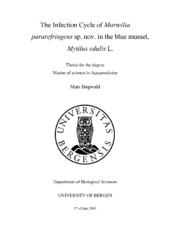| dc.description.abstract | In 2016 the first case of marteiliosis in Norway was reported by the Institute of Marine Research. The discovery occurred in Agapollen, Bømlo, a previously active oyster pond. The parasite Marteilia pararefringens sp. nov. was found to only infect mussels, Mytilus edulis, and not the cohabiting flat oysters, Ostrea edulis. In May 2018, 250 naïve mussels, Mytilus edulis, were deployed in a channel connected to the oyster pond to examine the transmission period and progression of Marteilia pararefringens in the host. In October 2018, another 250 naïve mussels were deployed to examine whether transmission could occur during sporulation of the parasite from the mussel host. Sampling of 30 mussels for PCR and histological analysis every six weeks. The transmission period was found to occur from July, based on PCR results. The first mussels were infected in August based on histological evidence. All target tissues (stomach epithelium, ducts, and digestive tubules) were infected at this time. Sporulation occurs from August to November, evidenced by the presence of advanced stages in digestive tubules and sporonts in the lumen of the digestive tract. The spread of the infection involves an exponential increase of the number of parasites per digestive tubule. The infection of M. pararefringens triggers a host haemocyte reaction associated with the infection intensity. Focal necrosis and degeneration of digestive tubules is often seen. Sporulation occurs in conjunction with the disruption and physiological dysfunctions of the digestive tubules, potentially leading to the death of the host. The second group (October to March) did not become infected. A cohabitation trial in the laboratory to see whether the parasite could infect healthy mussels (n = 100) from donor mussels (n = 50) was unsuccessful, indicating the need for an intermediate host. Plankton samples were PCR positive from July to October, coinciding with the transmission period of the parasite to the mussels. Therefore, the intermediate host could potentially be of planktonic origin. | en_US |
